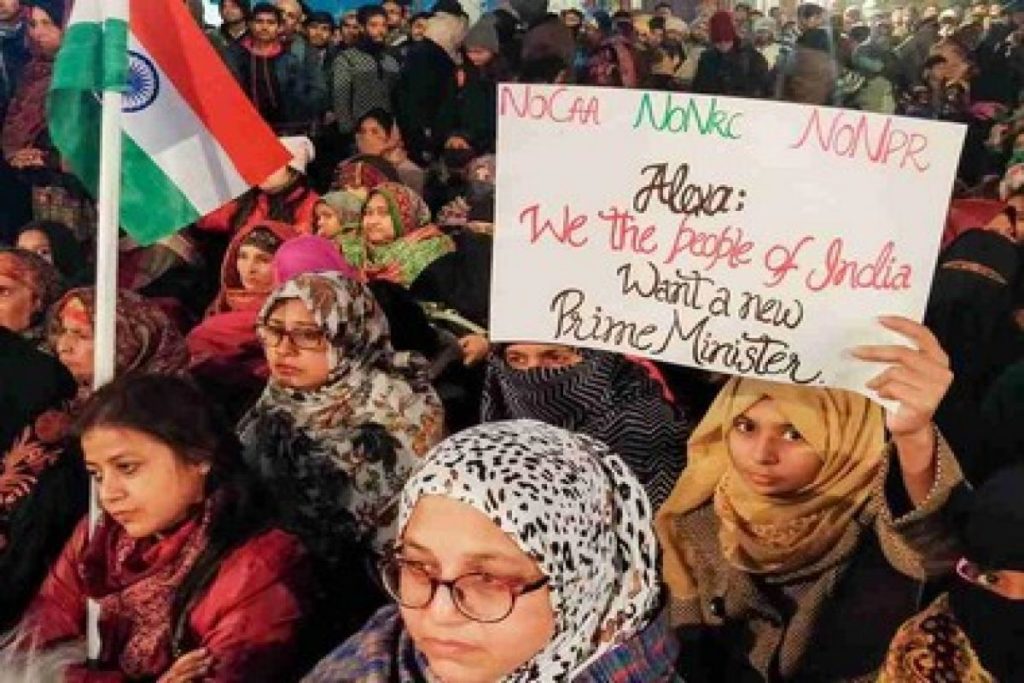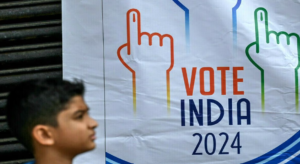Abdul Alim Jafri, Chandni Doulatramani and Ruchika Goswamy
Shaheen Bagh in Allahabad via Kanpur
Inspired by the resilient women of New Delhi’s Shaheen Bagh, whose month-long resistance against the CAA and NRC is making waves, large groups of women began a sit-in protest at Mansoor Ali Park of Roshan Bagh in Uttar Pradesh’s Prayagraj, formerly known as Allahabad, on the afternoon of 12th January, Sunday.
Over a thousand people, mainly women, sat late-night despite a cold wave sweeping across North India. They were also joined by student leaders and representatives from political parties, such as Congress and Samajwadi Party (SP).
“When men raise voices for their rights, the police puts them behind bars and prosecutes them, so we women have been forced to agitate to save our Constitution. If resilient women of New Delhi’s Shaheen Bagh, Kanpur, Gaya in Bihar can sit 24×7 in icy winds, why can’t we?” said Sara Ahmed, one of the key organisers of the protest.
The protesters are not just Muslims. People from all age groups and religions are participating in the sit-in, mainly by women.
Another organizer, Tarannum Khan, said, “At a time when women are constantly struggling in many places and fighting the government in this cold, how can we sit peacefully in Allahabad? It is a fight for our identity.”
For some, this is a fight to secure their children’s future. For others, it is a struggle for “peace” and protecting the country’s secular and democratic ethos.
“Our children’s future is at risk. We couldn’t sit at home, pretending everything’s fine. Laws are being framed to divide us in our own country. Women aged 80 years old and young children are all sitting in protest today. When we started the protest, there were only 40-45 women, but by night, the number had crossed thousand. Our protest is indefinite, and we will stand firmly against the government’s arbitrariness,” said a 50-year-old homemaker, asking not to be named.
In Uttar Pradesh’s Kanpur, sit-in protests in Mohammad Ali Park have been going on since January 7. The protest site was dotted with various kinds of placards and banners with the revolutionary song ‘Hum Dekhenge‘, written by Faiz Ahmed Faiz.
Similarly, Shanti Bagh in Bihar’s Gaya has also turned into a mini Shaheen Bagh where people from Hindu, Sikh and Muslims communities, mainly women and students, have been gathering 24×7 since December 29.
Protest reaches Kolkata
Since 7 January, the Park Circus Maidan in central Kolkata has been the site of a sit-in protest led by the women residents of Park Circus. The sit-in is inspired by the protest at Delhi’s Shaheen Bagh. The women are protesting the CAA–NPR–NRC and the brutal attacks on students in universities such as Jawaharal Nehru University, Jamia Millia Islamia and Aligarh Muslim University.
Park Circus is a predominantly Muslim neighborhood. The protest is taking place in a ground outside the local mosque. Unlike other anti-CAA protests in Kolkata, in which students and people from upper and middle-classes have participated, the Park Circus protest largely comprises working-class individuals.
Hundreds of women, some with their children, gather every day with posters and placards. Over time, the residents of Park Circus have been joined by others from across Kolkata. For a majority of the protesting women, this is their first time participating in a protest. The protestors say that they intend to be on an indefinite sit-in, until at least 22 January, when the Supreme Court is scheduled to hear petitions challenging the CAA. There is no single organisation visibly spearheading the protests. The ordinary public is leading the movement, and the only banner they are protesting under is the Indian flag.
On the afternoon of 8 January, a truck carrying several burqa-clad women arrived at the maidan. As they got down and walked towards the ground, several women chanted slogans, with calls for azadi—freedom—from communal politics. Dressed in a black burqa and dark sunglasses, Tabassum Akhtar, a 44-year-old resident of Ekbalpur in south Kolkata, led the sloganeering. “There is a fire in our hearts,” she said. “We are very angry. We have no direct relationship with the children of JNU, but they are our everything.”
Another protestor, 22-year-old Rafiqua Hayat, said that on 7 January, she chanted protest slogans for the first time in her life. Hayat is a recent graduate from Sivanath Sastri College, where she studied accounts and finance. Until a few months ago, she said, she had no interest in politics. She would spend all her internet data on Instagram and Facebook memes. Now, she regularly watches the news and keeps track of videos on the NRC and CAA to educate herself.
At the protest ground, a large space had been cleared out for the women. Thin sheets of grey and white foam, along with cotton mattresses, had been spread out. A makeshift barricade tied together with ropes aimed to keep men outside the space. Women led all the chants. Once in a while men took over, not to assert themselves, they said, but to give their “sisters” a break. In addition to the protestors, there were around a hundred volunteers at the protest site, distributing blankets, water bottles, boxes of Chinese food or biryani and endless cups of tea.
Mussarat Parveen is a 55-year-old resident of Ripon Street, located two kilometres away from the protest site. A widow with three sons, Parveen is a homemaker. She said she barely ever stepped out of her house, but now she believed she did not have a choice. “We have to do something to save the country,” she said. Several other women emphasised that they were homemakers who rarely left their homes, but added that Prime Minister Narendra Modi’s actions had “compelled” them to come out in protest.
Some women said that they were labourers foregoing their daily wage to attend the protest. A woman in her fifties said that she lives a few hundred metres from the protest site and cooks for families in the nearby neighbourhood of Malik Bazar. A single mother of three daughters, she barely makes five thousand rupees a month. She said she had been at the protest site for three days straight and had only gone home to take her medicines. “We have come here for our rights,” she said. “Why should we leave Hindustan? Why should we let Modi proceed with the CAA and NRC”?
On 9 January, 21-year-old Firdaus Saba, dressed in a brown hijab and royal-blue woollen shawl, chanted azadi slogans into a mic. The speakers behind her carried her chants through the crowd. Saba is a physics student at Kolkata’s Aliah University. This was her eighth protest as a sloganeer. On 8 January, when she left the campus to join the protests, she told her hostel authorities that she would not be back until the next day. She spent the entire night at the protest grounds chanting “Halla bol”—Raise your voice.
“I wanted to join the protests at Shaheen Bagh,” Saba said. “I couldn’t do that. I was able to see and participate in another Shaheen Bagh in Kolkata.” She passionately elaborated on the reasons she was protesting. “We are not Indian by chance; we are Indian by choice,” she said. “In 1947, we rejected the two-nation theory; we rejected an Islamic state. Today, our Hindu brothers and sisters will reject the Hindu nation. We didn’t choose Islamabad or Karachi, or Bangladesh, we chose India because it is a secular and democratic country.”
Saba added that in the founding vision of India, people were given the right to speak and the right to freedom of expression. “Why are we being stopped?” she said. “We have a right to equality. Why is that being taken away from us? Why is the Constitution being broken? We are not here as Muslims; we are here as Indians. We haven’t come here to save ourselves. We have come here to save the Constitution and the law. We will leave only after we have saved it.”
How can Kota women be behind?
New Delhi’s Shaheen Bagh protest has also inspired a similar sit-in in Kota.
More than a hundred Muslim women from different localities of the city began the sit-in outside the Eidgah grounds, calling it the Shaheen Bagh of Kota, on Tuesday night.
“When the women of the country are organising protests against the CAA and the proposed NRC, how could women of Kota be behind? The new law is a black law against the spirit of Constitution,” said 28-year-old Shifa Khalid, convenor of the sit-in.
“Women in Kota got inspired by the protesters of Shaheen Bagh. Our sit-in is also indefinite,” she added.
Khalid said women in the sit-in are getting food and blankets from the neighbourhood because most of the women are from Kishorepura locality, close to the venue of the sit-in. Women of all age groups from localities such as Vigyan Nagar, Waqf Nagar and Kishorepura are sitting in the protest since Tuesday night.
“I have joined the dharna because the government wants our documents to prove we are Indian citizens even though several generations of my family have lived here,” said Maqbool, 75, of Indira market locality.
Shabana Farhat, 39, travelled nine kilometre from her home near the railway station to join the protest. Despite the cold wave conditions in the city, she spent the night at the spot with more than half a dozen women.
“Many women go home to finish the household chores and return to the sit-in later. The sit-in will continue until the CAA is withdrawn,” she said.
Shaheen Bagh in Pune too
A large group of women have been on an indefinite dharna (sit-in) against the CAA–NPR–NRC outside Konark Indrayu Mall in Kondhwa, similar to the demonstration in New Delhi’s Shaheen Bagh neighbourhood.
Organised under the banner of Kul Jamat-e-Tanzeem, an umbrella organisation of like-minded local bodies, the sit-in entered the fourth day Monday with protesters claiming they would not step back until the government revoked the “unconstitutional” act.
“It is like Shaheen Bagh. Over 100 women and girls have been protesting overnight for the last four days, while some drop by between their daily schedule. We are planning to continue with the protest till the government revokes the Act. We have been telling people that the Act not only affects Muslims, but others as well. We are trying to protect the Constitution,” said Nazneen Shah, 40, a protester.
Since January 10, the venue has hosted a string of plays, occasional speeches and a volley of slogans against CAA and NRC. Protesters here have also vociferously condemned the attack on students in Jawaharlal Nehru University.
Protesters say that India today does not need NRC or CAA but requires employment, education and healthcare. “Most of these people were born here before the municipality was set up. They have no birth certificates. Some are not even educated to understand what is happening,” said Maeraj Shaikh, 22.
(Abdul Alim Jafri is correspondent at Newsclick; Chandni Doulatramani is an independent journalist based in Kolkata; Ruchika Goswamy is reporter with Indian Express.)




